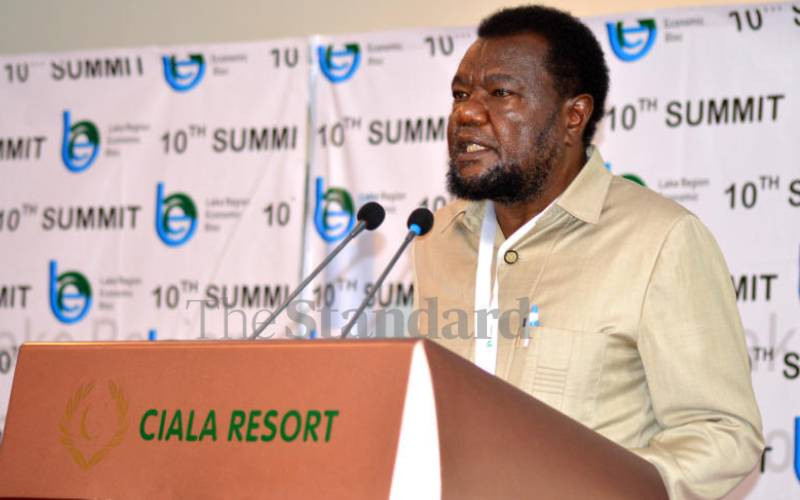The idea of forming regional economic blocs among counties is laudable. The plan by the Lake Region Economic Bloc (LREB) to establish a regional bank to support inter-county development should not cause apprehension among financial sector players.
Locally, jitters could be premised on a fallacy that Kenya is overbanked. It is important to put the idea of setting up a regional development bank into perspective to allay fears and debate that a lender for LREB is a bad idea, according to a recent opinion article in the Financial Standard. According to the article, Kenya is overbanked.
This can only be true to the extent of the large number of banks and microfinance institutions in Kenya but not their capacity to finance long-term productive sector projects or provide technical support and business advisory services to the counties.
Mostly, commercial banks cannot undertake long-term project financing of 20-30 years because they rely on deposits and savings which in gross is about 11 per cent nationally.
Also, commercial banks are unlikely to have the technical capacity to assess and determine the feasibility of key sector development projects designed to exploit value chain financing opportunities in counties.
Household saving
The Lake region hosts banks such as KCB, Barclays, and Equity. However, access to banking remains clustered in urban areas and there is limited access to appropriate business advisory services. There are also Saccos but household saving and deposit rates in the region is way below 10 per cent and just about 22 per cent of about 14 million population of the region have bank accounts.
The current financial sector establishment is not likely to mobilise adequate resources to support the magnitude of projects anticipated by a regional economic bloc.
The big unbanked population in the region requires more financial deepening and inclusion strategy. These strategies would help to increase the rate of marginal savings which is higher among the middle class.
The regional bank is meant to increase savings and financial inclusion. Recently, 14 counties around Lake Victoria and its environs namely Siaya, Homa Bay, Migori, Kakamega, Bungoma, Busia, Vihiga, Trans Nzoia, Kisii, Nyamira, Bomet, Kisumu, Nandi and Kericho agreed and formed LREB to leverage economies of scale in the region.
These include shared resources such as Lake Victoria and its rivers to improve the livelihoods of the locals. The LREB development bank is meant to unlock regional economic development in productive sectors such as agriculture, tourism, trade and industrialisation.
Historically, the idea of economic integration and establishment of regional development banks more responsive to aspirations of economies with geographical identities dates back to post World War II.
In the 1960s, three institutions were set up outside the UN system to give poor nations greater say in the control of international development finance: the Inter-American, African and Asian Development banks thus the idea of a regional development bank is not new.
Financing gaps
Such banks have played a vital role in financing long-term projects globally. The regional development banks globally have helped fill key financing gaps, especially in large-scale infrastructure projects and recently in social and environmental projects.
Stay informed. Subscribe to our newsletter
These financing gaps exist due to the limited capacity of States to undertake large projects or the private sector’s inability or unwillingness to undertake long-term or large-scale projects perceived as too risky.
A development bank is meant to stimulate trade and its effects such as the creation of economies of scale, and to spur economic development based on comparative advantages of economies. Besides, such lenders have become a source of entrepreneurship and technical support, especially in the coordination of regional policies, plans and utilisation of resources for intra-regional trade and technical development projects.
To strengthen the capital structure for LREB bank, the 14 counties have pledged Sh200 million each. However, without precaution, the belief that regional banks are naturally effective mediators in regional socio-economic development may turn out to be illusory.
The assertion of regional identity may claim greater regional autonomy in control of the use of resources which can be mistaken to be an act of political competition against national government’s economic hegemony. Caution is so necessary. It is thus not clear that a regional bank is an appropriate instrument for regional identity in exclusive terms.
-The writer is a development economist
 The Standard Group Plc is a
multi-media organization with investments in media platforms spanning newspaper
print operations, television, radio broadcasting, digital and online services. The
Standard Group is recognized as a leading multi-media house in Kenya with a key
influence in matters of national and international interest.
The Standard Group Plc is a
multi-media organization with investments in media platforms spanning newspaper
print operations, television, radio broadcasting, digital and online services. The
Standard Group is recognized as a leading multi-media house in Kenya with a key
influence in matters of national and international interest.
 The Standard Group Plc is a
multi-media organization with investments in media platforms spanning newspaper
print operations, television, radio broadcasting, digital and online services. The
Standard Group is recognized as a leading multi-media house in Kenya with a key
influence in matters of national and international interest.
The Standard Group Plc is a
multi-media organization with investments in media platforms spanning newspaper
print operations, television, radio broadcasting, digital and online services. The
Standard Group is recognized as a leading multi-media house in Kenya with a key
influence in matters of national and international interest.





